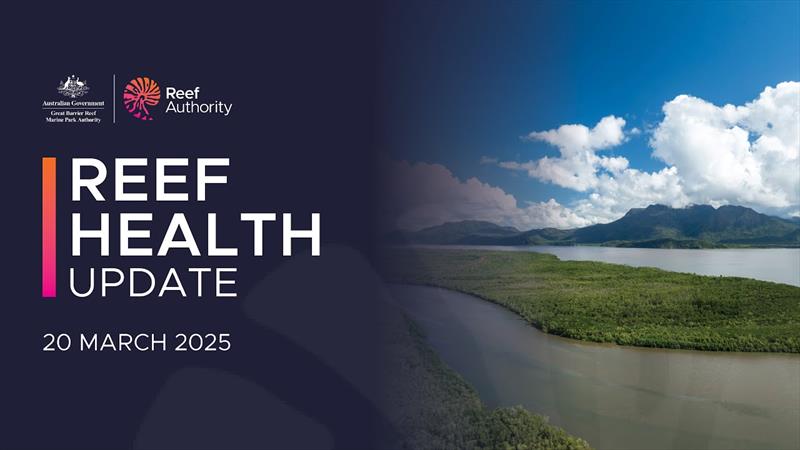
Great Barrier Reef Health Update | 20 March 2025
by Great Barrier Reef Marine Park Authority 20 Mar 08:35 UTC
20 March 2025

Reef Health Update | 20 March 2025 © Great Barrier Reef Marine Park Authority
As the lead managers of the Great Barrier Reef, the Reef Authority keeps an eye on the Reef year-round — with efforts stepped up over summer, a typically high-risk period from extreme weather.
The Reef Authority releases updates on the health of Reef which includes; sea surface temperatures, rainfall and floods, cyclones, crown-of-thorns starfish outbreaks, and coral disease.
These updates are based on forecasts, water temperature heat mapping, in-water surveys, citizen science and aerial surveys.
Reef Health update | 20 March 2025
The aerial surveys we conducted with the Australian Institute of Marine Science revealed varying levels of shallow water coral bleaching on surveyed reefs between Townsville and the tip of Cape York.
Impacts from flooding were also detected in the shallows of some reefs, mostly offshore Ingham and Innisfail where there were high levels of flood plume exposure.
The aerial surveys were focused on the Far Northern, Northern and Central regions of the Marine Park, which had the greatest exposure to thermal stress and rainfall driven flood plumes.
Survey flights were not conducted across the southern region where heat stress and flooding has been comparatively less.
Detailed analysis of the aerial survey data is under way.
Temperatures
Clear weather across the Marine Park early last week increased sea surface temperatures, that then decreased with the onset of cloud and thunderstorm activity off the northern and central Queensland coast.
Cloud cover and thunderstorms are forecast to continue in the week ahead, potentially leading to further decreases in sea surface temperatures across the Marine Park.
Over the past week, in the Far Northern region sea surface temperatures remained at 1.3 degreesC above the long-term average for March. Across all other regions, sea surface temperatures increased above the March average — by 0.3 degreesC to 1.2 degreesC in the Northern region, by 0.1 degreesC to 0.8 degreesC in the Central region, and 0.3 degreesC to 0.9 degreesC in the Southern region.
Across the Marine Park, sea surface temperatures are forecast to remain 0.7 degreesC to 1 degreesC above the long-term average for April.
Rainfall
In the coming week, the Bureau of Meteorology forecasts many areas of the Marine Park catchment will receive more rain than usual for late March. While this will likely have a cooling effect, it could also lead to further flooding and freshwater intrusion to the Marine Park.
Reef health
The Reef Authority partnered with its Australian Institute of Marine Science colleagues to conduct aerial surveys across the Far Northern, Northern, and Central regions of the Marine Park— from Cape York in the north to Townsville in the south.
The coral bleaching observed by the aerial surveys was variable across the regions - with some reefs exhibiting no evidence of coral bleaching, while most ranged from low to high levels of coral bleaching. There was little evidence of extreme coral bleaching. The higher levels of coral bleaching were more frequently recorded on reefs surveyed near Princess Charlotte Bay in the Far North of the Marine Park.
Aerial and in-water observations of flood impacts to shallow coral reef communities indicate significant impacts to inshore habitats between Innisfail and Townsville.
The Reef Authority will conduct in-water surveys in the Northern, Central, and Southern regions over the next month, with a focus on assessing the impacts of heat stress and flood impacts.
During the past fortnight —February 27 to March 13 — 270 in-water Reef Health Impact Surveys were conducted across the Marine Park. Mostly lower-level coral bleaching was reported at 24 of the 30 reefs surveyed. Reports of either no coral bleaching or low-level prevalence (1-10%) were received from the Central and Southern regions. Most reports of coral bleaching from the Northern region were of low (1-10%) to medium-level (11-30%) prevalence.
Reef management
Information from in-water and aerial surveys is still be analysed and will be presented in the Summer Reef Snapshot in the coming weeks once analysis is complete.
The Reef Authority, Queensland Parks and Wildlife Service, and many other organisations are working hard to support Reef resilience, including enforcing compliance with the Reef's zoning plan, controlling crown-of-thorns starfish outbreaks, and taking action to minimise catchment runoff into the Reef.